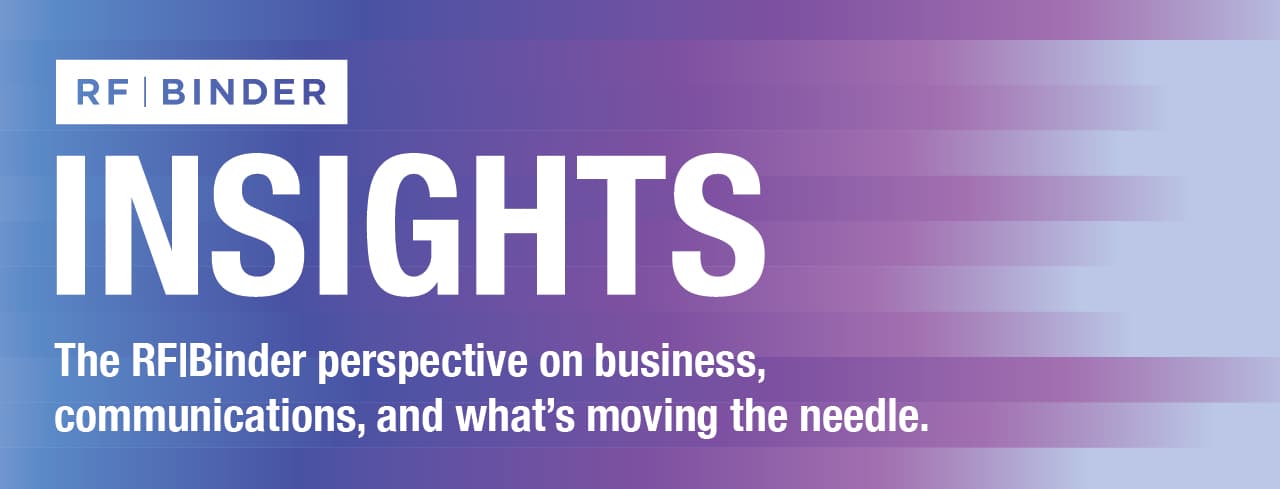Last year, RF|Binder took a significant step in its sustainability journey by joining 1% for the Planet, a global organization dedicated to inspiring action and fostering a thriving future for our planet and generations to come.
As part of this commitment, RF|Binder allocates 1% of its revenues to support solutions for some of the world’s most pressing environmental challenges.
The membership reflects one of the agency’s guiding principles that “business can be a force for good,” and underscores a long-standing dedication to sustainability. Since its founding, RF|Binder has championed sustainable practices both within the firm and on behalf of its clients, recognizing the critical role businesses must play in addressing the climate crisis.
Membership has its rewards – from attending 1% for the Planet events, to upping our work for people and the planet. And equally rewarding has been the work the two organizations have done together to tell 1% for the Planet’s story to a wider audience. It is a partnership that has yielded some interesting communications lessons and inspiring best practices:
The Story’s the Thing
From its origin story to its compelling examples of businesses working in partnership with nonprofits across its network, 1% for the Planet deploys a powerful brand of storytelling to illustrate the organization’s positive impact on people and the planet. The movement started with its own story—Yvon Chouinard, founder of Patagonia, and Craig Mathews, founder of Blue Ribbon Flies, conceived of 1% for the Planet on a fishing trip on the Madison River, creating a way for companies to be responsible for protecting the resources from which they profit.
Today, innovative partnerships, such as Flickr’s work with the Conservation Alliance to establish a new Chuckwalla National Monument and expanded Joshua Tree National Park, protecting over 800,000 acres, or 818 Tequila’s affiliation with S.A.C.R.E.D and its Bricks Program, demonstrate the positive impact of businesses donating a portion of their sales to environmental causes, inspiring others to join the movement and take action for the planet, and creating a deeper connection with their customers.
The Network Effect
The power of 1% for the Planet’s impact lies in its theory of change: “simple, smart actions done repeatedly in community add up to change at scale.” Individually, each business member makes its own unique contribution, but when added up with the actions of thousands of other business members, that collective effort is what moves the needle.
This theory of change is embedded into the organization’s communications platform, from website content to social media to events, and it inspires new companies to join, more collaborations to form between businesses and environmental partners, and a deepening of the commitment to 1% for the Planet’s mission. “From a psychological perspective, I think this commitment translates into pride,” said Allyson Bartlett, VP of Brand & Marketing at 1% for the Planet. “That pride creates a sense of accomplishment and belonging. When people share that pride with others, it becomes a bonding experience, amplifying the impact.”
The Power of the Mark
Communications isn’t just about nouns and verbs. At 1% for the Planet, the organization’s unique logo is one of the most powerful tools in its communications toolbox – a potent stamp of approval that resonates across key stakeholders. You can find it on packaging, websites, marketing materials and social media and it helps build the movement by inspiring new businesses and environmental partners to join 1% for the Planet.
“A great logo draws its power not from design alone but from the actions and values of the organization it represents,” said David Weinstock, chief creative officer at RF Binder. “The 1% for the Planet logo resonates with consumers and businesses because it symbolizes purpose-driven impact and inspires trust.”
That said, good design plays an important role in suggesting the organizations, personality, tone and meaning to its audience. “The brand incorporates consumer-friendly typography and a simple, clear, approach to visually align with its environmental mission. Their logotype is an effective tool for communicating the organization’s purpose and fostering connection to their members and the public,” added Weinstock.
And the data confirm this. Member companies report that the 1% for the Planet brand gives them access to new clients and connections, improved advertising and marketing performance, improved hiring and deeper employee engagement and retention. And 70% of members see revenue growth year-over-year.
Research conducted through the Harris Poll also found that 46% of U.S. consumers say that seeing the logo on a product positively influences their purchasing decision. Similar results were found in France, Australia, Germany, Japan and the United Kingdom.
The In-person Experience
With nearly 5,000 business members and 7,200 environmental partners, 1% for the Planet is a global, diverse and dispersed organization. But one of its most effective communications devices are events that bring people together. These in-person events – Sessions events (local network gatherings in cities across the country and around the world) and the Global Summit – are a cauldron of communications alchemy that inform, inspire, and drive action.
We live in an increasingly digital world, and it is easy to forget how impactful face-to-face communication can be. But meeting peers at the New York Sessions event last September, or celebrating inspiring stories from Africa, South America and Baja at the most recent Global Summit in San Diego, reinforce why in-person events remain a powerful tool for forging genuine connections and creating lasting memories.
“The energy of our in-person events is incredible,” said Kate Williams, 1% for the Planet CEO. “It’s not just about how the events are set up, but also about who our network is. That ‘magic’ exists within our network all the time, but events let us experience it in a tangible way. Only a fraction of our network can attend these events in any given year, but these moments are energizing and impactful and they’re possible because we have a strong, global, and diffuse network operating all the time.”
Authentic Leadership
For any organization, especially those that are mission-driven, 1% for the Planet reminds us of the importance of authentic leadership, which is closely tied to effective communication. Whether addressing a crowd at an event or delivering an interview, CEO Kate Williams always speaks from a place of passion for 1% for the Planet’s mission and what the organization can accomplish. She has a wonderful story about her own leadership practice that is both engaging and connected to the core values of 1% for the Planet. In turn, she inspires her team members to stay focused on their goals.
It would be hard for the business members and environmental partners that comprise the 1% for the Planet network to not be inspired by this example of authentic leadership. When brands communicate authentically about their own sustainability initiatives and impact, they build trust, demonstrate transparency, and encourage dialogue. This has become a communications expectation on the part of consumers, among other important stakeholders.

